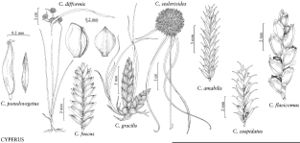Difference between revisions of "Cyperus fuscus"
Sp. Pl. 1: 46. 1753.
FNA>Volume Importer |
imported>Volume Importer |
||
| (2 intermediate revisions by 2 users not shown) | |||
| Line 8: | Line 8: | ||
}} | }} | ||
|common_names=Brown galingale | |common_names=Brown galingale | ||
| + | |special_status={{Treatment/ID/Special_status | ||
| + | |code=I | ||
| + | |label=Introduced | ||
| + | }}{{Treatment/ID/Special_status | ||
| + | |code=F | ||
| + | |label=Illustrated | ||
| + | }} | ||
|basionyms= | |basionyms= | ||
|synonyms= | |synonyms= | ||
| Line 24: | Line 31: | ||
|elevation=0–1700 m | |elevation=0–1700 m | ||
|distribution=Ont.;Que.;Calif.;Conn.;Md.;Mass.;Mo.;Nebr.;Nev.;N.J.;Pa.;S.Dak.;Va.;Eurasia. | |distribution=Ont.;Que.;Calif.;Conn.;Md.;Mass.;Mo.;Nebr.;Nev.;N.J.;Pa.;S.Dak.;Va.;Eurasia. | ||
| + | |introduced=true | ||
|discussion=<p>A native of temperate Eurasia, <i>Cyperus fuscus</i> is intermittently adventive and locally established 35°–45° N latitude. The report from New York (M. L. Fernald 1950) is based on a misidentification of <i>C. diandrus</i> (R. S. Mitchell and G. C. Tucker 1997).</p> | |discussion=<p>A native of temperate Eurasia, <i>Cyperus fuscus</i> is intermittently adventive and locally established 35°–45° N latitude. The report from New York (M. L. Fernald 1950) is based on a misidentification of <i>C. diandrus</i> (R. S. Mitchell and G. C. Tucker 1997).</p> | ||
|tables= | |tables= | ||
| Line 47: | Line 55: | ||
|publication title=Sp. Pl. | |publication title=Sp. Pl. | ||
|publication year=1753 | |publication year=1753 | ||
| − | |special status= | + | |special status=Introduced;Illustrated |
| − | |source xml=https:// | + | |source xml=https://bitbucket.org/aafc-mbb/fna-data-curation/src/2e0870ddd59836b60bcf96646a41e87ea5a5943a/coarse_grained_fna_xml/V23/V23_244.xml |
|genus=Cyperus | |genus=Cyperus | ||
|subgenus=Cyperus subg. Pycnostachys | |subgenus=Cyperus subg. Pycnostachys | ||
Latest revision as of 20:39, 5 November 2020
Herbs, annual, cespitose. Culms trigonous, 2–30 cm × 0.6–1.1 mm, glabrous. Leaves flat, 4–10 cm × 2–4 mm. Inflorescences: rays 1–3, 0.2–1.5 cm; 2d order rays present in robust plants, to 5 mm; bracts 2–3, longest erect, others spreading, 1–20 cm × 1.5–3 mm. Spikelets 3–12, narrowly ellipsoid, flattened, 3–7 × 0.9–1.2 mm; floral scales 8–12(–16), laterally purplish brown, medially greenish yellow, 3-ribbed medially, orbiculate, 0.9–1.1 × 1 mm, apex mucronate. Flowers: stamen 1; anthers ellipsoid, 0.2 mm, connective not prolonged; styles 0.3–0.4 mm; stigmas 0.3 mm. Achenes light brown, ellipsoid, 0.7–0.9 × 0.4 mm, base barely stipelike to narrowly cuneate, apex acute, surfaces glabrous.
Phenology: Fruiting summer.
Habitat: Damp, disturbed soils, emergent shorelines, puddles
Elevation: 0–1700 m
Distribution

Introduced; Ont., Que., Calif., Conn., Md., Mass., Mo., Nebr., Nev., N.J., Pa., S.Dak., Va., Eurasia.
Discussion
A native of temperate Eurasia, Cyperus fuscus is intermittently adventive and locally established 35°–45° N latitude. The report from New York (M. L. Fernald 1950) is based on a misidentification of C. diandrus (R. S. Mitchell and G. C. Tucker 1997).
Selected References
None.
